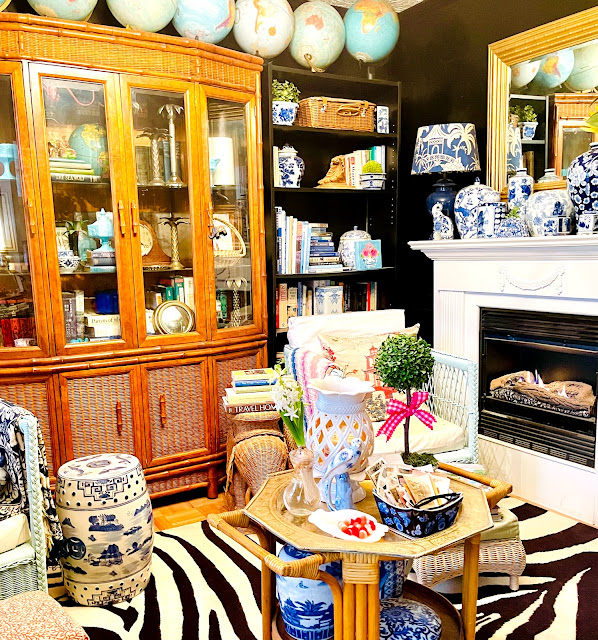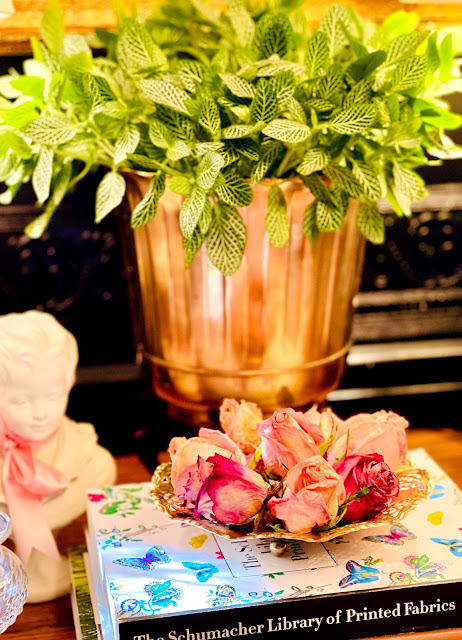I was mopping the floors the other day (loooonnnngggg overdue, I might add) and realized it had been 8 months since I painted the black and white checked floor in our downstairs Powder Room. They've held up very well so I posted a "reel" on Instagram and there were some questions about how difficult it was to paint.
It is very easy - just a little time consuming because of the drying time in between each step.It really doesn't take any special skills and once you do a little measuring and figure out a couple of simple things then it's just a matter of following the steps below.

I'm going to explain what I did, how I went about it and what I used. There are a lot of tutorials and paint information available. This isn't the only way, it's just my way of going about this.
This Powder Room refresh was part of a One Room Challenge which is a great motivator for me. We were in the middle of pandemic lockdown, stuck at home and what was available was in short supply. I might have done a few things differently if circumstances had been different but the floors turned out great using what I had on hand and have held up very well! If you want to see the blog posts documenting the ORC process you will find them here:
To begin with I painted the walls, cabinet, everything and left the floors for the very last.
This is the same process I use to get crisp lines on my wall stripes.
I sanded the floors a little to be sure any shiny finish was removed. Then I painted the floors with oil based primer using a small sponge roller. I had small spaces to get into so the small roller worked well. You can see below that it's pretty splotchy.
I did 2 light coats of primer but I have read that 1 is sufficient. This room
gets a lot of traffic so I wanted it have a tough finish. The
next step was to basecoat the floors with white paint. I had a gallon of Sherwin Williams DTM in gloss white on hand. It is formulated for metal but this was during total lockdown so I went for it. It is very shiny and I like that! I would have normally used SW Exterior or Deck Floor paint in bright white.
Then I measured and decided the size of squares I wanted to use and that I wanted to place them on the diagonal. Some people call this a "harlequin" floor but harlequin floors actually use a diamond shape not a square.
With my room size I found that I could do a 16" square and have it work out very evenly. I also determined where I wanted a full 16" square to fall (in front of toilet) so I started with a half square on the far wall. I think it works very well to measure your space and then divide by 12, 14. 16 etc to see how the squares work out the best. Or you can simply use a 12" square and go for it. Some people like to plot it out on graph paper. This is a great thing to do if you are having trouble visualizing. I'm more of a "it's only paint - let's go for it" kind of person! This was not my first painted checked floor so I could visualize what I wanted.
I let the 2 coats of white floor paint dry 24 hours- just to be sure - before I started taping.
You will need a LOT of blue painters tape!
I taped my long diagonal lines first. I used a metal ruler to measure my spacing, made light pencil marls and then taped just to the outside of the mark. I used a 4' level to double check that my tape lines were not wavy. Then I measured and taped off the squares. You are taping just outside the mark because these will be the squares you paint black. I put a dot of blue tape in each square that I am NOT painting to be a visual reminder. Anything to help from becoming confused. You can do every other row.
Here is the BIG tip!! This is the key to crisp, straight edges...
If you look closely at the blue tape above you can see that I have painted along the edge with the white base color. I use a 1/2 inch or less brush and just lightly paint along the inside edge of my squares - the ones that will be black. This paint will seal the edge of the tape and you won't have black seeping under the tape. It requires one more step and drying time but you won't have to try and touch up afterwards!! So worth it. I never ever skip this step!!
Then I used a 4" foam roller that I had on hand to fill in the black squares. I used Sherwin Williams ProMar 100 Exterior Paint in Tricorn Black to paint my squares. This is my go-to glossy black paint so I had it on hand but this is what I would have used even if I hadn't been in lockdown.
This picture is the answer to the question, "Why does Cooper always have paint on him??"
#neverfarfrommyside

Let the final coat of black paint dry completely and then the fun part - pulling the tape and revealing the crisp painted squares. Mollie was going to help but Cooper beat her to it!!
It really is easy and a great way to get a beautiful floor for very low cost too!!Just measure twice, double check that you've taped off correctly before you paint and then don't skip the step where you paint along the tape edges.
If you do that you will have a beautiful floor.
I can't wait to see your painted floors!




















































